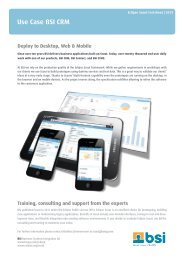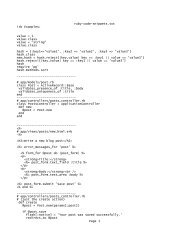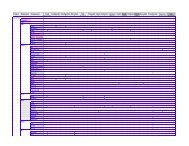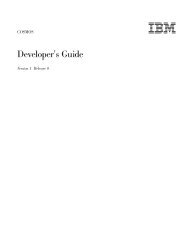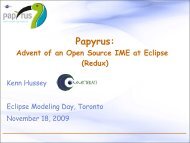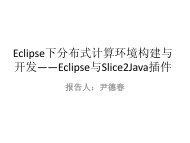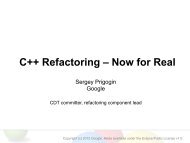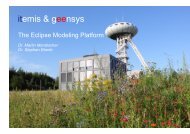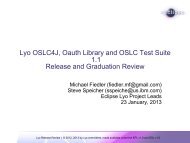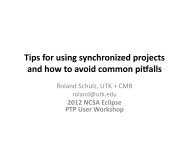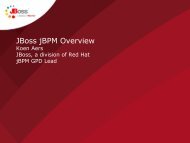Download
Download
Download
Create successful ePaper yourself
Turn your PDF publications into a flip-book with our unique Google optimized e-Paper software.
Design Document<br />
CDT Remote Search/Index Framework<br />
Chris Recoskie<br />
Vivian Kong<br />
Mike Kucera<br />
Jason Montojo<br />
IBM Corporation<br />
RemoteIndexDesign.doc<br />
Copyright ©2006 IBM Corporation<br />
Distributed under the Eclipse Public License v1.0<br />
Page 1 of 26
1 Introduction<br />
1.1 Purpose<br />
The purpose of this document is to describe a design for a set of modifications to<br />
CDT that would introduce a framework for enabling ISVs to extend CDT with<br />
remote development capabilities. The modifications would be centered on<br />
making the search and index features of CDT extensible in such a way as to<br />
allow them to be used with resources that exist on a remote system in an efficient<br />
manner.<br />
Motivation for this proposal is based on the following considerations:<br />
• Users developing high performance computing applications targeting IBM<br />
POWER architecture on System p servers<br />
• Systems are generally centralized at some remote location, and are often<br />
leased.<br />
o Latent network connectivity.<br />
o Large number of other simultaneous users on the same machine.<br />
o Bandwidth, CPU, and memory are metered and literally expensive.<br />
• Running certain tools such as an Eclipse-based integrated development<br />
environment is sometimes not possible or is not feasible due to poor<br />
graphical user interface rendering performance.<br />
• Parsing and indexing remotely are required for such users to make use of<br />
critical value adds of Eclipse/CDT such as content assist, navigation,<br />
search, etc., because the files do not all live locally.<br />
The first part of this proposal involves decoupling the current parser and index<br />
subsystems from CDT so that they may be built as standalone JAR files. Once<br />
these JARs are available it will be possible to deploy the parser and indexer in an<br />
environment where eclipse/CDT is not available (such as on a remote system).<br />
There are several uses for standalone jars:<br />
• Deploy the parser and indexer remotely. This would be useful for tools that<br />
need to parse files remotely but currently do not have the luxury of having<br />
a CDT project in the workspace (such as TPF Toolkit).<br />
• Provide a library for C/C++ parsing/indexing that would be usable by<br />
anyone interested in having this functionality but who does not need the<br />
Eclipse and CDT frameworks.<br />
RemoteIndexDesign.doc<br />
Copyright ©2006 IBM Corporation<br />
Distributed under the Eclipse Public License v1.0<br />
Page 2 of 26
• Provide a tool that could be used to generate offline indexes for SDKs.<br />
This would be useful for the current offline indexing proposal. SDK<br />
vendors could provide CDT indexes by using a simple command line tool.<br />
1.2 Scope<br />
The scope of this document is to describe the design for a framework that would<br />
allow remote searching and indexing capabilities to be added to CDT. This<br />
document does not address the mechanism by which remote files would be<br />
accessed. This would be the responsibility of an ISV that would develop their<br />
remote development solution on top of the framework that is being proposed in<br />
this document. This design does not address remote build and remote debug<br />
capabilities.<br />
1.3 Related Documents<br />
There is a bugzilla created for this proposal:<br />
https://bugs.eclipse.org/bugs/show_bug.cgi?id=158975<br />
This design is closely related to the project model subsystem within CDT.<br />
http://download.eclipse.org/tools/cdt/docs/summit2006/New_Project_Model_UI_0<br />
6.09.25.ppt<br />
In addition there are several Bugzilla entries related to the indexer and parser<br />
components of CDT that are closely related to this design.<br />
https://bugs.eclipse.org/bugs/show_bug.cgi?id=151846<br />
https://bugs.eclipse.org/bugs/show_bug.cgi?id=151847<br />
https://bugs.eclipse.org/bugs/show_bug.cgi?id=158975<br />
PDOM paging scheme: https://bugs.eclipse.org/bugs/show_bug.cgi?id=165451<br />
1.4 References<br />
Links are provided to supporting reference material.<br />
EFS<br />
http://wiki.eclipse.org/index.php/EFS<br />
RSE (Remote System Explorer)<br />
http://www-304.ibm.com/jct09002c/isv/rational/remote_system_explorer.html<br />
DAO Design Pattern<br />
http://java.sun.com/blueprints/corej2eepatterns/Patterns/DataAccessObject.html<br />
1.5 Stakeholders<br />
A list of primary stakeholders, in no particular order:<br />
RemoteIndexDesign.doc<br />
Copyright ©2006 IBM Corporation<br />
Distributed under the Eclipse Public License v1.0<br />
Page 3 of 26
o Beth Tibbits, IBM (PTP Project Committer)<br />
• Support for remote system development targeting POWER<br />
platform.<br />
o Ankit Pasricha, IBM<br />
• CDT integration in TPF toolkit.<br />
• Parser and Indexer JAR files.<br />
o Craig Rasmussen, Los Alamos National Laboratory (Photran & PTP<br />
Projects Committer)<br />
1.6 Points of Contact<br />
• Primary contact: Chris Recoskie, IBM Corporation, recoskie@ca.ibm.com<br />
• Primary contact: Jason Montojo, IBM Corporation, jmontojo@ca.ibm.com<br />
• Primary contact: Mike Kucera, IBM Corporation, mkucera@ca.ibm.com<br />
• Primary contact: Vivian Kong, IBM Corporation, vivkong@ca.ibm.com<br />
1.7 Glossary<br />
Term Definition<br />
CDT The C Development Tools project hosted on Eclipse.org<br />
ISV Independent Software Vendor. Used as a general term to describe<br />
software developers which customize CDT, as opposed to someone<br />
who uses CDT as an end-user.<br />
User An end-user to CDT.<br />
EFS Eclipse File System. A virtual file system API used by the Eclipse<br />
platform. It abstracts away implementation details of how files in the<br />
workspace are stored.<br />
JAR Java Archive file. A ZIP file used to package and distribute a set of<br />
java classes. Stores compiled Java classes and associated<br />
Remote<br />
plug-in<br />
metadata that can constitute a program.<br />
A plug-in or set of plug-ins that would enable remote development<br />
using CDT. The design proposed in this document would enable a<br />
remote plug-in to be built on top of CDT.<br />
Index A data structure that can be stored on disk that provides fast lookup<br />
of identifiers within the source code of a program.<br />
Parser A program that translates a text file consisting of source code (for<br />
example C or C++) into a data structure (AST).<br />
AST Abstract Syntax Tree. A data structure that represents the structure<br />
of a source code file.<br />
RSE Remote System Explorer. An Eclipse plug-in that allows users to<br />
create connections to remote servers and explore their file systems.<br />
RemoteIndexDesign.doc<br />
Copyright ©2006 IBM Corporation<br />
Distributed under the Eclipse Public License v1.0<br />
Page 4 of 26
2 Design Overview<br />
The central idea of the design involves significantly loosening the coupling<br />
between the index APIs and the UI controller code that uses them. This must be<br />
done in order to achieve the level of modularity that the design requires.<br />
There exists an enterprise design pattern for this purpose, the Data Access<br />
Objects (DAO) design pattern. This pattern is commonly used in Java web<br />
applications to create an abstraction layer that encapsulates the implementation<br />
of persistent storage (such as a relational database). The front end of the<br />
application communicates with the DAO layer via transfer objects, which are<br />
value objects that contain the results of queries or contain data that is to be<br />
persisted.<br />
This pattern involves defining a clear separation between the code that accesses<br />
the index and the code that displays the results. The data access layer can be<br />
easily swapped out and replaced with another one without affecting the rest of<br />
the application. This pattern is most often used in the web development world<br />
when working with an architecture that involves a controller framework on the<br />
front end and a relational database on the back end. The parallel between this<br />
setup and the architecture of CDT is obvious.<br />
Web Application CDT<br />
Controller<br />
(eg. Servlets)<br />
DAO Layer<br />
JDBC<br />
Relational<br />
Database<br />
Transfer<br />
Objects<br />
Controller<br />
(eg. Views, Search)<br />
DAO Layer<br />
PDOM<br />
RemoteIndexDesign.doc<br />
Copyright ©2006 IBM Corporation<br />
Distributed under the Eclipse Public License v1.0<br />
Page 5 of 26<br />
Transfer<br />
Objects<br />
Index API
The proposed design includes the following:<br />
• Migrating the CDT codebase such that all resource management is<br />
implemented on top of EFS. This will allow any resource to transparently<br />
exist on a remote system. Normal file operations, such as opening a file in<br />
the editor, would work as expected even for remote resources.<br />
• Applying the DAO pattern to provide a layer that separates index related<br />
operations from clients that need the results of those operations. This will<br />
allow a 3 rd party plug-in to enable remote index features on top of CDT by<br />
providing its own implementation of the DAO layer. Presumably this<br />
implementation will provide a DAO layer that is actually a proxy that<br />
communicates with the remote machine.<br />
CDT Local Scenario<br />
Controller<br />
(eg. Views)<br />
DAO Layer<br />
PDOM<br />
Transfer<br />
Objects<br />
Index API<br />
CDT Remote Scenario<br />
Remote System<br />
Controller<br />
(eg. Views)<br />
PDOM<br />
• An extension point for adding custom implementations of the DAO layer.<br />
• A default implementation of the DAO layer based on the PDOM.<br />
• A manager for the DAO framework that would handle reading of the<br />
extension point and mapping of a particular DAO implementation to a<br />
particular resource. This would allow more than one DAO implementation<br />
RemoteIndexDesign.doc<br />
Copyright ©2006 IBM Corporation<br />
Distributed under the Eclipse Public License v1.0<br />
Page 6 of 26<br />
Transfer<br />
Objects<br />
DAO Proxy Layer<br />
Remote Agent<br />
Serialized<br />
Transfer Objects<br />
Index API
to coexist, allowing local resources to be indexed in a local PDOM and<br />
remote resources to be indexed on the remote system.<br />
• Decoupling the current CDT parser and index subsystems<br />
to allow<br />
deployment as standalone components outside of CDT. This would allow<br />
a remote index agent to exist on a remote machine without Eclipse/CDT<br />
present.<br />
• The PDOM based DAO layer could also be made part of a standalone<br />
JAR so that it may be reused on the remote machine by the remote agent.<br />
2.1.1 Additional benefits of the DAO Design Pattern:<br />
• Loose coupling between UI Controller code and the PDOM subsystem<br />
leads to improved maintainability.<br />
• The DAO layer provides a well defined<br />
interface that can be documented.<br />
• Much easier to replace the PDOM with a new Indexing technology in the<br />
future if it is ever needed.<br />
• Makes unit testing UI Controller<br />
code easier as DAO objects can be easily<br />
simulated by mock objects.<br />
• Makes testing index functionality<br />
easier via a test suite for the DAO layer.<br />
ISVs could reuse this test suite when implementing their own DAO layer.<br />
2.2<br />
Background<br />
2.2.1 Indexing and the PDOM<br />
PDOM Index<br />
References<br />
Declarations<br />
AST<br />
Source Editor<br />
CModel<br />
Definitions Delta<br />
Tokenized/<br />
parsed<br />
source<br />
Parser<br />
Changes in source code<br />
Actual<br />
source files<br />
Indexer<br />
RemoteIndexDesign.doc<br />
Copyright ©2006 IBM Corporation<br />
Distributed under the Eclipse Public License v1.0<br />
Page 7 of 26<br />
Affected elements from model<br />
List of source files
CDT uses a hierarchical model called the CModel to represent resources within<br />
CDT projects. This model can be viewed by users via the C/C++ Projects View.<br />
The process of indexing source code in CDT happens in multiple phases. When<br />
a user makes changes to their source code, the changes are analyzed with<br />
respect to the core project model (CModel). Each element in the model is an<br />
ICElement. The corresponding ICElements for projects, folders and source files<br />
are ICProjects, ICContainers, and ITranslationUnits, respectively. The<br />
ICElements that are affected by the user’s changes are collected and stored in a<br />
delta.<br />
RemoteIndexDesign.doc<br />
Copyright ©2006 IBM Corporation<br />
Distributed under the Eclipse Public License v1.0<br />
Page 8 of 26<br />
CModel elements<br />
The indexer analyzes the delta to determine which files need to be indexed. The<br />
contents of these files are then passed to the parser. The parser extracts<br />
structural information from the source code and produces Abstract Syntax Trees<br />
(AST). Finally, the indexer extracts semantic information from the ASTs, such as<br />
class and variable references, declarations, and definitions, and stores that in the<br />
PDOM index.<br />
2.2.2 Project Natures<br />
CDT provides project natures for C and C++. When the CModel is built all the<br />
projects in the workspace are scanned. Any project with the C or C++ nature is<br />
then added to the CModel (as a CProject element).
2.3 Current Behaviour<br />
All search and index functionality is currently designed to be highly dependant on<br />
the PDOM subsystem. All of the UI controller code has been written to use the<br />
low level PDOM Index APIs directly. This means that the index functionality<br />
cannot be treated in a modular way and cannot be swapped out.<br />
Currently there are two extension points that are directly related to the new<br />
design:<br />
• Indexers are contributed via an extension point.<br />
• Content assist is provided by completion contributors that are defined in<br />
an extension point.<br />
2.4<br />
UI<br />
Content Assist<br />
C/C++ Search<br />
Index View<br />
Call Hierarchy<br />
Navigation<br />
Include Browser<br />
Proposed Behaviour<br />
Existing Usage Model<br />
PDOM Index<br />
We<br />
envision a scenario where remote development capabilities are built on top of<br />
CDT by a separate plug-in or set of plug-ins. CDT would provide the framework<br />
that would allow this to be possible. This set of 3<br />
ent.<br />
rd party plug-ins will be<br />
henceforth referred to as the “remote plug-in” for the remainder of this docum<br />
The<br />
new EFS API will enable remote resources to exist in the Eclipse<br />
workspaces<br />
alongside local resources. In order to take advantage of this CDT will<br />
need to be migrated to EFS. This has the additional benefit of allowing CDT to be<br />
RemoteIndexDesign.doc<br />
Copyright ©2006 IBM Corporation<br />
Distributed under the Eclipse Public License v1.0<br />
Page 9 of 26
used with other EFS supported file systems, for example a Zip file could be<br />
mounted into the workspace using an EFS Zip file implementation.<br />
Simply providing remote resources via EFS is not sufficient to provide the level of<br />
performance of remote development that may be required. The reason is that file<br />
operations on EFS remote files may cause the file to be transferred over the wire<br />
to a local cache folder.<br />
This is not desirable for performance reasons, for<br />
example indexing all the files in a project could cause all the files to be<br />
transferred locally.<br />
It is the responsibility of the<br />
remote plug-in to provide an implementation of EFS<br />
for accessing the remote files. The remote plug-in will probably also need to<br />
provide its own workspace<br />
projects and manage the resources in those projects.<br />
The C or C++ nature would then be applied to these projects allowing CDT to<br />
recognize them and add them to the CModel. This in turn enables all of the CDT<br />
functionality to work on the remote resources (by pretending<br />
they are local<br />
resources<br />
in the workspace). If the remote plug-in is not concerned with<br />
efficiency then this is all that it needs to provide. However, if the remote plug-in<br />
wants to provide a remote index as well, then it can participate in our proposed<br />
DAO service<br />
framework.<br />
(There is an alternate usage scenario that does not involve the necessity to<br />
provide<br />
an EFS implementation.<br />
It will be possible for an ISV to use CDT<br />
components<br />
directly without actually using CDT as a framework. In this case an<br />
implementation of EFS may not be required.)<br />
In order to enable remote search and index functionality in an efficient manner it<br />
would be necessary to have an agent on the remote system that provides an<br />
index for the files located there. In order to facilitate this we propose to provide<br />
stand-alone JAR files that contain the CDT parser and indexer subsystems. The<br />
goal<br />
is to make it possible to deploy the parser and indexer on a remote system<br />
where the Eclipse/CDT framework may not be available.<br />
There will be an extension point for contributing implementations of our proposed<br />
DAO service framework. This implementation will provide implementations of<br />
search and index functionality that will communicate with the agent on the remote<br />
system.<br />
There will be a DAO Manager component that will be responsible for mapping a<br />
workspace file to a DAO service. This mechanism will allow more that one DAO<br />
implementation to coexist (enabling local and remote projects to live side by<br />
side). If more than one project type is involved, for example if a local and a<br />
remote project are included<br />
in a search scope, then CDT must make use of each<br />
mapped<br />
DAO factory and combine the results.<br />
RemoteIndexDesign.doc<br />
Copyright ©2006 IBM Corporation<br />
Distributed under the Eclipse Public License v1.0<br />
Page 10 of 26
A remote indexer would be contributed using the current extension point for<br />
indexers. The remote plug-in would then manually associate its indexer with its<br />
remote project using IIndexManager.setIndexerId(ICProject project, String<br />
indexerId). This registers the remote indexer to receive deltas.<br />
2.5 Transition Plan<br />
The CDT codebase will need to be transitioned to use the EFS APIs exclusively<br />
for resource management.<br />
The current PDOM based search/index functionality will be factored out into an<br />
implementation of the DAO service framework and then contributed via the new<br />
extension point.<br />
2 .6 Risks<br />
• Re-architecting CDT to facilitate remote development may impact the<br />
performance of CDT for local development. We must ensure this change<br />
does not slow down CDT in any way.<br />
• Since the majority of CDT users do not require remote development<br />
capabilities, the community may resist changing the existing architecture.<br />
• It is possible that future clients of the index system will require full access<br />
to the index. This is an issue for remote development because the entire<br />
index may potentially be transferred to the local side.<br />
2.7 Assumptions<br />
• The CDT parser and indexer subsystems can be decoupled from CDT<br />
and packaged as standalone components.<br />
• Clients of the index service extension point are responsible for providing<br />
the necessary bridging to connect their remote<br />
services with CDT. The<br />
CDT parser and indexer will be provided as reusable components for the<br />
remote systems.<br />
• The remote system provides its own Java 1.4-compliant runtime<br />
environment.<br />
2.8 Dependencies<br />
• The proposed design introduces a dependency on EFS.<br />
RemoteIndexDesign.doc<br />
Copyright ©2006 IBM Corporation<br />
Distributed under the Eclipse Public License v1.0<br />
Page 11 of 26
3<br />
Requirements and Usage<br />
3.1 Problem Statement<br />
• Allow ISVs<br />
to implement remote development on top of CDT without<br />
significantly changing the user experience.<br />
3.2 User Characteristics<br />
Users of this system fall into two main categories: end users and ISVs.<br />
3.2.1<br />
For<br />
the purpose of this document an Independent Software Vendor is any<br />
software<br />
development firm that would be interested in extending CDT by adding<br />
remote development capabilities.<br />
ISVs are interested in the framework and public<br />
API that would be used to develop a remote plug-in.<br />
3.2.2<br />
ISVs<br />
End Users<br />
End us ers are users which are using CDT in order to work on some project. End<br />
users may<br />
also be using the remote plug-in to interact with C/C++ files that exist<br />
on a remote system. The user experience should not be significantly different<br />
betwee n using a local project and a remote project. For example the C/C++<br />
search dialog should be the same, and other actions such as find references<br />
should be triggered in the same way. End users expect a consistent user<br />
experience.<br />
The<br />
goal of a consistent experience<br />
is ultimately a lofty one. It is likely that the<br />
remot e plug-in will have to provide its own interface for interacting<br />
with the<br />
remot<br />
e system. Furthermore, when working with remote resources<br />
there are<br />
problems<br />
with slow or unreliable connections. These will have to be dealt with.<br />
3.3 Use Cases<br />
The following are a set of use cases<br />
which define typical usage of the system<br />
from<br />
the end-user perspective. Since the use cases are relatively simple and<br />
straightforward, a brief prose description<br />
for each will be used rather than a<br />
detailed<br />
description involving primary actors, success scenarios, etc.<br />
RemoteIndexDesign.doc<br />
Copyright ©2006 IBM Corporation<br />
Distributed under the Eclipse Public License v1.0<br />
Page 12 of 26
Ultimately it is the responsibility of the designers of the remote plug-in to<br />
determine<br />
the user experience of their software. The user interface and usage<br />
scenarios of CDT will not be significantly changed by this design. Usage<br />
scenarios will still be described here for reference.<br />
3 .3.1 C/C++ Search<br />
3.3.1.1 The user invokes the C/C++ search dialog via the Search menu or the<br />
toolbar.<br />
3.3.1.2 The user enters search criteria into the dialog including the search string.<br />
Checkboxes are used to select the type of C/C++ language element to<br />
search for.<br />
3.3.1.3 The user chooses the scope of the search by choosing a set of projects,<br />
then clicks the search button.<br />
3.3.1.4 The system passes the scope to the IndexDAOManager which returns<br />
search DAO which is used to perform the search.<br />
3.3.1.5 If a remote<br />
project is included in the scope then the remote index agent<br />
will be contacted and the search will be performed on the remote<br />
system. The search results will be sent back from the remote system.<br />
3.3.1.6 Search results are collected and displayed to the user in the C/C++<br />
Search Results view. If there is a combination of local and remote search<br />
results they will be combined and displayed together in the view.<br />
3.3.2 Find References/Declarations<br />
3.3.2.1 The user selects a one of the following: 1) An identifier in the source<br />
code editor, 2) an element in the outline view, 3) an element in the<br />
C/C++ projects view.<br />
3.3.2.2 The user invokes the pop-up menu and chooses to search for references<br />
or declarations.<br />
3.3.2.3 The system finds the project that contains the selected element and uses<br />
it as the search scope.<br />
3.3.2.4 Go to 3.3.1.4.<br />
RemoteIndexDesign.doc<br />
Copyright ©2006 IBM Corporation<br />
Distributed under the Eclipse Public License v1.0<br />
Page 13 of 26<br />
a
3.3.3 Content Assist<br />
3.3.3.1 The user types some source code into the source code editor. The user<br />
invokes content<br />
assist by clicking Ctrl-Space.<br />
3.3.3.2 The system determines the project that contains the source file<br />
3.3.3.3 The system obtains a Content Assist DAO from the IndexDAOManager .<br />
A Content Assist DAO is treated the same way as a Completion<br />
Contributor. All of the available completion contributors are invoked to<br />
provide the content assist.<br />
3.3.3.4 If the project is a remote project then the remote agent will be<br />
contacted and the completions will be calculated on<br />
the remote system.<br />
A set of completions will then be sent back. These completions will be<br />
combined with any completions that were calculated locally (for example<br />
keyword or template completions) and displayed to the user.<br />
3.3.4 Index View<br />
3.3.4.1<br />
3.3.4.4<br />
The user chooses to display the C/C++ index view using the Window<br />
menu.<br />
3.3.4.2 The index view displays a set of projects as its topmost elements.<br />
Remote projects will be displayed but will not be expanded by default.<br />
3.3.4.3 The user chooses to expand a remote project.<br />
The system retrieves the Index Structure DAO that is mapped to the<br />
project that is to be expanded. This will contact the remote agent and be<br />
used to display the content under the remote project in the index view.<br />
3.3.5 Navigation - Open Declaration/Definition<br />
3.3.5.1 The user selects a one of the following: 1) An identifier in the source<br />
code editor, 2) an element in the outline view, 3) an element in the<br />
C/C++ projects view<br />
3.3.5.2<br />
The user invokes the pop-up menu and chooses to open the declaration<br />
or the definition.<br />
3.3.5.3 The system finds the project that contains the selected element and<br />
retrieves the corresponding Navigation DAO which is used to find the<br />
source code location of the definition or declaration.<br />
RemoteIndexDesign.doc<br />
Copyright ©2006 IBM Corporation<br />
Distributed under the Eclipse Public License v1.0<br />
Page 14 of 26
3.3.5.4 If the selected file<br />
is under a remote project then the remote agent will<br />
be contacted and the source file and code location of the<br />
declaration/definition will be sent back.<br />
3.3.5.5 The appropriate file is opened in the editor and the location of the<br />
declaration/definition is selected. If the file was located on a remote<br />
system then a copy is transferred locally so that it may be displayed in<br />
the editor.<br />
3.3.6 Call<br />
Hierarchy<br />
3.3.6.1 The user selects a function or method in one of the following ways 1) as<br />
an identifier in the source code editor, 2) an element in the outline<br />
view,<br />
3) an element in the C/C++ Projects View.<br />
3.3.6.2<br />
3.3.6.3 The system finds<br />
the project that contains the selected function/method<br />
and retrieves the corresponding Call Hierarchy DAO which is used to<br />
populate the Call Hierarchy view.<br />
3.3.6.4 If the file is part of a remote project then the remote agent will be<br />
contacted and the call hierarchy will be computed on the remote system.<br />
3.3.7.2<br />
The user right clicks and chooses to open the call hierarchy view from<br />
the pop-up menu.<br />
3.3.7 Include Browser<br />
3.3.7.1 The user opens the include browser view using the Window menu.<br />
The user drags a source code file on to the Include Browser View<br />
3.3.7.3 The system determines the project that contains<br />
the selected file. The<br />
corresponding Include Browser DAO, this is used to populate the view.<br />
3.3.7.4 If the file is part of a remote project then the include dependencies will<br />
be computed by the remote<br />
agent and sent back.<br />
RemoteIndexDesign.doc<br />
Copyright ©2006 IBM Corporation<br />
Distributed under the Eclipse Public License v1.0<br />
Page 15 of 26
3.3.8 Create New Project<br />
3.3.8.1 The remote plug-in will have to provide its<br />
own new project wizard.<br />
Presumably this will create a remote enabled project in the workspace<br />
and apply a C nature to it. The resources in the remote project will need<br />
to be implemented on top of EFS<br />
3.3.8.2 Any time the<br />
user chooses to perform an index or search related<br />
operation the DAO factory that is associated with the new project will be<br />
used by the IndexDAOManager.<br />
3.3.9 Type<br />
Hierarchy<br />
3.3.9.1 The type hierarchy view is not implemented yet.<br />
3.4 Global<br />
Decisions and Tradeoffs<br />
This design comes with the consequence that any search/index action may now<br />
be triggering communication with a remote system. Thus the problems of network<br />
communications<br />
become a concern in many places in CDT. Since the remote<br />
plug-in<br />
is contributing implementations of all the search and index features, and<br />
since CDT has no knowledge of the remote system or the communications<br />
protocol used, it is decided that all concerns of network communication errors be<br />
the responsibility of the remote plug-in. This means that the remote plug-in must<br />
be sufficiently robust as to not cause CDT to hang or crash.<br />
Since there may be bandwidth limitations this design will take into consideration<br />
that the information transmitted between the local system and the remote system<br />
be kept as small as possible. Entire files should not be transmitted when it is not<br />
necessary.<br />
A search should result in only the results being sent back from the<br />
remote system and not entire files. Indexing should take place on the remote<br />
system, indexing of existing remote files should not require them to be<br />
transfer red to the client machine. These requirements have been taken into<br />
consideration<br />
with this design.<br />
It has been identified that the on-disk index can be up to three times larger than<br />
the corresponding source code. For this reason it is desirable to avoid<br />
transmitting index nodes over the wire when not necessary. All index access will<br />
be encapsulated within the various Providers that are part of the<br />
IIndexDAOServiceFactory interface.<br />
RemoteIndexDesign.doc<br />
Copyright ©2006 IBM Corporation<br />
Distributed under the Eclipse Public License v1.0<br />
Page 16 of 26
3.5 Functional Requirements<br />
The new framework will provide the following functionality to the developers of<br />
the remote<br />
plug-in.<br />
• The ability to provide an implementation IIndexDAOFactory through an<br />
extension point.<br />
• The<br />
ability to specify a mappings between a DAO Factory and a resource.<br />
This mapping would be maintained by the DAO Factory itself via a<br />
method that takes an object representing a resource and returns true only<br />
if the factory applies to that object. A default DAO factory will apply if none<br />
of the other factories<br />
applies.<br />
• In the case that more than one IIndexDAOFactory<br />
is involved in a search<br />
query, CDT will be responsible for combining the results<br />
into one<br />
consistent search results view.<br />
• The ability to programmatically associate an indexer with a project. This<br />
already exists in IIndexManager.setIndexerId(). This is a concern because<br />
we are not changing the extension point for providing indexers.<br />
• CDT will provide deltas of file changes that will be passed to the remote<br />
indexer.<br />
3.6 Performance Requirements<br />
Since there may be memory restrictions on the remote system the index will<br />
implement a memory paging algorithm. This will allow the amount of memory that<br />
is used by the index to be tuned.<br />
3.7 Security Requirements<br />
Security requirements are the responsibility of the remote plug-in.<br />
4 High Level Design<br />
4.1 Architecture Overview<br />
The IIndexDAOFactory is designed to decouple knowledge of the index<br />
implementation from the UI layer. Instead of querying the index directly, the UI<br />
uses DAO objects that it obtains from the IndexDAOManager to provide<br />
content<br />
RemoteIndexDesign.doc<br />
Copyright ©2006 IBM Corporation<br />
Distributed under the Eclipse Public License v1.0<br />
Page 17 of 26
that<br />
it will ultimately be displayed to the user. Each DAO provided by an<br />
IIndexDAOFactory corresponds to a UI component.<br />
UI IIndexDAOFactory<br />
Content Assist<br />
C/C++ Search<br />
Index View<br />
Call Hierarchy<br />
Navigation<br />
Include Browser<br />
4.2 Component Listing<br />
4.2.1 IIndexDAOFactory<br />
Proposed Usage<br />
Model<br />
The IIndexDAOFactory provides access to a number of index-related<br />
services.<br />
Each<br />
service is specific to a user operation and is handled by one of<br />
the Data<br />
Access<br />
Objects listed below. DAO objects are stateless.<br />
4.2.2 Content Assist DAO<br />
IIndexDAOManager<br />
Content Assist DAO<br />
C/C++ Search DAO<br />
Index Structure DAO<br />
Call Hierarchy DAO<br />
Navigation DAO<br />
Include Browser DAO<br />
The Content Assist DAO supplies a list<br />
of possible completions for the current<br />
cursor position within a source editor.<br />
The completions may be type names,<br />
variables, functions, keywords, or even freeform text.<br />
RemoteIndexDesign.doc<br />
Copyright ©2006 IBM Corporation<br />
Distributed under the Eclipse Public License v1.0<br />
Page 18 of 26<br />
PDOM Index
4.2.3 C/C++ Search DAO<br />
The C/C++ Search DAO performs syntax- and semantic-sensitive searches on<br />
source code. The provider supplies a structured set of search results to the UI.<br />
Each search result contains the location of the match so the UI can display and<br />
highlight it.<br />
4.2.4 Call Hierarchy DAO<br />
The Call Hierarchy DAO finds and returns all the callers (functions which call it)<br />
or<br />
callees (functions which it calls) of a given function or method. Multiple calls to<br />
the provider can produce a complete call tree.<br />
RemoteIndexDesign.doc<br />
Copyright ©2006 IBM Corporation<br />
Distributed under the Eclipse Public License v1.0<br />
Page 19 of 26
4.2.5 Index Structure DAO<br />
The Index Structure DAO gives its clients access to an ICElement hierarchy<br />
representing the contents of the index. This provider may return the entire<br />
hierarchy, or a proxy which incrementally fetches portions of the hierarchy on<br />
demand as it is traversed.<br />
4.2.6 Navigation DAO<br />
The Navigation DAO performs lookups for the declaration or definition of a<br />
named type or variable. The provider returns the location of the named element<br />
so the UI can display and highlight it to the user.<br />
4.2.7 Include Browser DAO<br />
The Include Browser DAO provides<br />
its clients with a list of files included by a<br />
particular<br />
source file. By making multiple calls to the provider, a client can<br />
construct complete include trees for source files.<br />
RemoteIndexDesign.doc<br />
Copyright ©2006 IBM Corporation<br />
Distributed under the Eclipse Public License v1.0<br />
Page 20 of 26
4.2.8 IndexDAOManager<br />
The IndexDAOManager provides the following:<br />
• Reads the extension point registry to discover implementations of<br />
IIndexDAOFactory.<br />
• Maintains a list of contributed<br />
DAO Factories. There will be one DAO<br />
factory that is considered the default (presumably this will be the PDOM<br />
based implementation).<br />
• Provides methods for getting DAOs, for example getSearchDAO(). The<br />
Manager will use its list of DAO factories to create the DAOs. Composite<br />
DAOs may be built in the case where more than one factory applies to a<br />
given set of resources.<br />
• Determines when a DAO Factory applies to a given resource.<br />
4.3 Data Structures<br />
Not applicable.<br />
4.4 Example Usage<br />
The<br />
following diagram illustrates how an ISV can architect a solution for enabling<br />
CDT development on a remote system:<br />
UI<br />
Local System (CDT)<br />
Remote System<br />
CDT Indexer CDT Parser PDOM Index<br />
LocalIndexDAOFactory<br />
RemoteIndexDAOFactory<br />
Implemented by ISV<br />
Remote Agent<br />
RemoteIndexDesign.doc<br />
Copyright ©2006 IBM Corporation<br />
Distributed under the Eclipse Public License v1.0<br />
Page 21 of 26<br />
Remote Proxy<br />
CDT Indexer CDT Parser PDOM Index
5 Detailed Design<br />
5.1 Component<br />
Interrelations<br />
The following diagram displays<br />
a subset of the components that are involved in<br />
the design. The IndexDAOManager is used by client code to gain access to DAO<br />
objects . The IndexDAOManager uses the IIndexDAOFactory to create the DAO<br />
objects. Each DAO has associated transfer objects for returning results. Only the<br />
Call<br />
Hierarchy and Search related DAOs are given in the diagram, other DAOs<br />
will work<br />
in a similar fashion.<br />
RemoteIndexDesign.doc<br />
Copyright ©2006 IBM Corporation<br />
Distributed under the Eclipse Public License v1.0<br />
Page 22 of 26
The above diagram is not complete, it is meant to show a high level idea of how<br />
the DAO API will work.<br />
The various get methods of IIndexDAOServiceFactory are allowed to return null,<br />
this way a remote plug-in may selectively implement a subset of the potential<br />
functionality.<br />
6 Interface Design<br />
6.1 API Evolution<br />
The public API has been designed so that it may be easily evolved in the future<br />
without breaking clients. For this reason the IndexDAOManager class and the<br />
IIndexDAOFactory interface both have a single method for gaining access to all<br />
types of DAO object:<br />
Object getDAO(String daoID)<br />
IndexDAOManager will contain static final fields for the default set of PDOM<br />
DAOs. Example usage would look like:<br />
ISearchDAO dao = (ISearchDAO)<br />
IndexDAOManager.getDAO(IndexDAOManager.ID_SEARCH_DAO);<br />
Adding new DAO interfaces in the future will not require any changes to the<br />
public method interface of IndexDAOManager or IIndexDAOFactory. To add a<br />
new DAO interface it would be necessary to add a new static final field for the<br />
DAO’s ID.<br />
In order to add specific index-related functionality it suffices to add a new DAO<br />
interface. For example, if the call-hierarchy view needs new functionality from the<br />
Call Hierarchy DAO this would be done by adding a whole new DAO interface<br />
with the required method instead of begetting a new subinterface of<br />
ICallHierarchDAO. This would not affect existing clients as they are not required<br />
to implement the new interface.<br />
6.2 Extension Points<br />
The design impacts upon three extension points:<br />
RemoteIndexDesign.doc<br />
Copyright ©2006 IBM Corporation<br />
Distributed under the Eclipse Public License v1.0<br />
Page 23 of 26
1) A new extension point for contributing implementations of<br />
IIndexDAOServiceFactory will be added. Below is the proposed extension<br />
schema.<br />
2) There currently exists an extension point for contributing indexers. This<br />
would simply be reused (without changes) for contributing a remote<br />
enabled indexer. The remote plug-in<br />
would be responsible for mapping the<br />
appropriate remote indexer to a remote project. There currently exists a<br />
way to do this programmatically through IIndexManager. In order to<br />
facilitate this it is proposed that setIndexerId()<br />
method be included in the<br />
IIndexManager interface.<br />
3) There currently exists an extension point for content assist.This extension<br />
point will remain untouched because it is used to provide completion<br />
contrubitors that apply to any type of project, such as the keyword<br />
completion contributor. It will also be possible to contribute completion<br />
contributors via new the new IIndexDAOFactory extension point. It may be<br />
necessary<br />
to make all completion contributors return the same kind of<br />
transfer object regardless of which extension point is used to provide the<br />
completion contributor.<br />
6.3 Public API Listing<br />
This section contains a summary JavaDoc of a subset of the proposed API.<br />
6.4 Class IndexDAOManager<br />
java.lang.Object<br />
IndexDAOManager<br />
public<br />
class IndexDAOManager<br />
extends java.lang.Object<br />
RemoteIndexDesign.doc<br />
Copyright ©2006 IBM Corporation<br />
Distributed under the Eclipse Public License v1.0<br />
Page 24 of 26
Singleton used by client code to gain access to DAO objects, will return the<br />
appropriate<br />
DAO based on the given scope.<br />
Field Summary<br />
static java.lang.String ID_CALL_HIERARCHY_DAO<br />
static java.lang.String ID_SEARCH_DAO<br />
Constructor Summary<br />
IndexDAOManager()<br />
Method Summary<br />
java.lang.Object getDAO(java.lang.String id)<br />
Returns a DAO for the given DAO ID, or null if no DAO Factory<br />
is applicable to the given ID.<br />
Example Usage:<br />
ISearchDAO dao = (ISearchDAO)<br />
IndexDAOManager.getDAO(IndexDAOManager.ID_SEARCH_DAO);<br />
6.5 Interface IIndexDAOFactory<br />
public<br />
interface IIndexDAOFactory<br />
A factory for creating DAO objects.<br />
Method Summary<br />
java.lang.Object getDAO(java.lang.String id)<br />
Returns a DAO for the given DAO ID, or null if no DAO<br />
Factory is applicable to the given ID.<br />
boolean isApplicable(java.lang.Object<br />
element)<br />
Returns true only if the given scope element should be<br />
handled by this DAO factory.<br />
RemoteIndexDesign.doc<br />
Copyright ©2006 IBM Corporation<br />
Distributed under the Eclipse Public License v1.0<br />
Page 25 of 26
7 Revision History<br />
Revision<br />
Number<br />
Date Authors Notes<br />
1.0 Dec 7, 2006 Chris Recoskie<br />
Jason Montojo<br />
Vivian Kong<br />
Initial design.<br />
Michael Kucera<br />
2.0 Dec 14, 2006 Michael Kucera Changed to include DAO pattern<br />
terminology. Removed dependency<br />
on ICElement from design. Added<br />
new diagrams.<br />
2.1 Dec 20, 2006 Michael Kucera More generic getDAO() methods.<br />
Added section on API evolution.<br />
RemoteIndexDesign.doc<br />
Copyright ©2006 IBM Corporation<br />
Distributed under the Eclipse Public License v1.0<br />
Page 26 of 26



